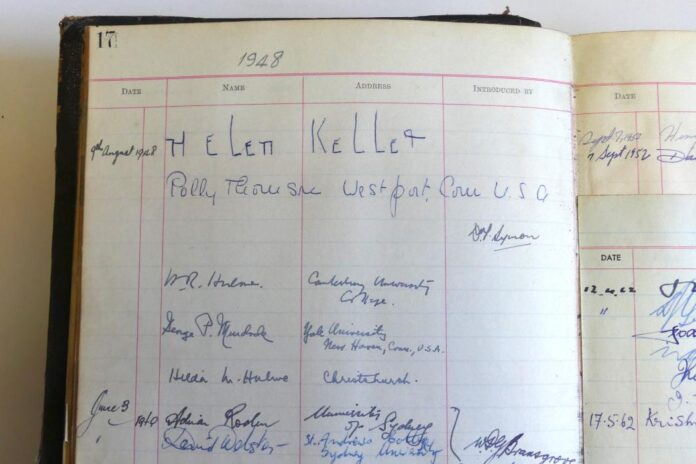Source: University of Canterbury
23 March 2021
More used to handling rare antiquities thousands of years old, the curator of the University of Canterbury’s Teece Museum and James Logie Memorial Collection describes a recent discovery as a “thrilling moment of wonder”.
-
As part of her tour, Helen Keller visited the Christchurch branch of the Blind and Low Vision New Zealand Institute on 30 July and gave a public talk for staff and students of Canterbury University College a few days later. According to the details on this page, Helen Keller visited Canterbury University College with one Polly Thomson on 9 August 1948.
Tiktok conspiracy theorists may not believe it but Helen Keller not only existed, she visited the University of Canterbury (UC) and – as archivists recently discovered – left her mark while she was there.
UC curator Terri Elder has been leading a mission to discover the University’s hidden treasures ahead of its upcoming 150th anniversary celebrations in 2023.
More used to handling rare antiquities that are thousands of years old, the curator of UC’s Teece Museum and James Logie Memorial Collection describes the recent discovery as offering a “thrilling moment of wonder”.
Here, she details the discovery of Keller’s signature:
While exploring the UCSA archives, the survey team found a historic book with the title “Students Club Visitors Book” embossed on the front. Visitors to the university, dating back to 1907, had signed their names and from where they had visited. On the 17th page, a familiar name jumped out at us in unusual-looking block letters: “Helen Keller”.
According to the details on the page, this Helen Keller visited Canterbury University College with one Polly Thomson on 9th August 1948. Following some quick research, we learned that the famous Helen Keller did indeed visit Christchurch in August 1948 as part of her post-war tour of Australia and New Zealand. During the tour, Miss Keller visited institutions to interact with the blind and deaf communities and offer messages of hope.
As part of her tour, she visited the Christchurch branch of the Blind and Low Vision New Zealand Institute on 30th July, and followed this by giving a public talk for staff and students of Canterbury University College a few days later on 9th August. Acting Rector at the time, Robin Allan, wrote to express his thanks the following day, noting that “Your wise words, and if I may be permitted to say so, the fine example of your courage will have an abiding effect on a group of students at a formative stage in their careers.”
It was an exciting discovery to find Miss Keller’s distinctive handwritten name across the page of the Visitors Book. Polly Thomson, whose name is written in the next entry, was Miss Keller’s close companion and, together with Miss Keller, visited over 35 countries on behalf of the American Foundation for the Overseas Blind. Finding Miss Keller and Miss Thomson’s names was another reminder how valuable it can be to keep historical archives and material, as they can give us important clues to our history, while also providing moments of wonder.
About the UC history project
The Canterbury College Collection Survey project, funded by a Lotteries Environment and Heritage grant, has located and catalogued over 150 artefacts or groups of artefacts from across the University. This project aimed to complete a survey of historic, pre-1957 artefacts at the University of Canterbury – established in 1873 – related specifically to the buildings, staff, and students of the original Canterbury College site (now The Arts Centre). The artefacts include tools, furniture, transportation, instruments, regalia, and general memorabilia that have come from the Canterbury College site or were used by staff and students between 1873-1957.
“Among those artefacts have been some significant finds which tell the fascinating story of our institution and of tertiary education in New Zealand, and which bring to life the stories of the staff and students who have contributed to both this University and the wider community,” Elder says.
“This year we are working with the UC Foundation to apply for a grant to initiate another phase of the project, capturing information about UC artefacts from the post-1957 period.”
Making antiquities more ‘visible’
While UC’s Equity & Disability Service (EDS) supports students with disabilities by providing disability-related study support services and specialist resources, at the Teece Museum, an audio descriptions project aims to make the museum’s Logie Collection exhibits more accessible for those with vision impairment.
“Audio descriptions detail the physical nature of particularly special or important pieces from our collection, allowing listeners to develop a mental picture of the artefact, so that they can then engage with the exhibition more fully, and discuss interpretations with their family and friends,” Elder says. “The descriptions are written by UC student volunteers, who attend training sessions, and then research and write their descriptions with assistance from UC staff.”
Audio descriptions are available while Teece Museum visitors are in the gallery (located in Old Chemistry at The Arts Centre) or online at home. The first audio files are now online on the Museum webpage and on the Teece Museum’s YouTube channel.
-
While exploring the UCSA archives, the survey team found a historic book with the title “Students Club Visitors Book” embossed on the front. Visitors to the university, dating back to 1907 signed their names and from where they had visited. On the 17th page, a familiar name jumped out: “Helen Keller”.



